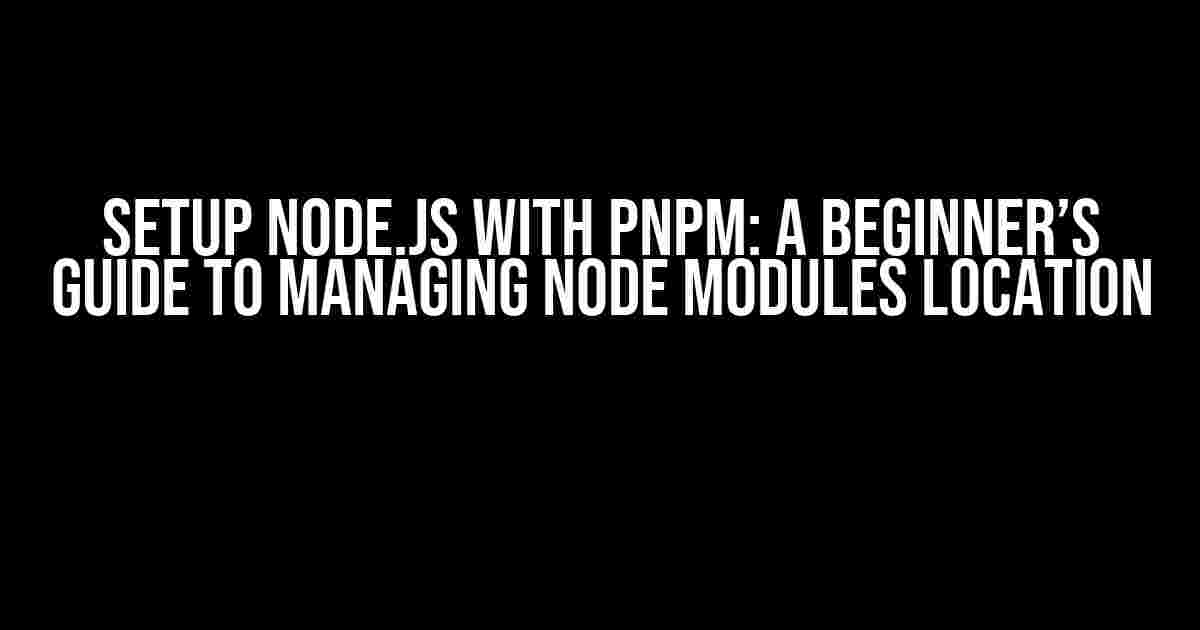Welcome to the world of Node.js, where setting up your project can be a breeze with the right tools! In this article, we’ll explore how to setup Node.js with pnpm, a popular package manager, and dive into the world of node modules location. Buckle up, folks, and let’s get started!
What is pnpm?
pnpm (performant npm) is a package manager for Node.js that aims to provide a fast, reliable, and secure way to manage your project’s dependencies. It’s designed to be a drop-in replacement for npm (the default package manager for Node.js) and yarn. pnpm boasts impressive performance, thanks to its unique approach to managing dependencies, making it a popular choice among developers.
Why Choose pnpm Over npm or yarn?
Here are some compelling reasons to choose pnpm over npm or yarn:
- Faster Installation**: pnpm is significantly faster than npm and yarn, thanks to its clever use of hard links and symlinks.
- Smaller Storage**: pnpm stores dependencies more efficiently, reducing the overall size of your node_modules directory.
- Improved Security**: pnpm uses a Content-Addressed Storage (CAS) to store dependencies, ensuring the integrity of your project’s dependencies.
- Better Error Handling**: pnpm provides more informative error messages and a more robust error handling mechanism.
Setting Up Node.js with pnpm
To get started with pnpm, you’ll need to install it globally on your system. Open your terminal and run the following command:
npm install -g pnpmOnce installed, you can verify the installation by running:
pnpm --versionInitializing a New Project with pnpm
Create a new directory for your project and navigate into it in your terminal. Then, run the following command to initialize a new project with pnpm:
pnpm initFollow the prompts to set up your project’s details, such as the project name, version, and description.
Managing Node Modules Location with pnpm
One of the most significant advantages of using pnpm is its ability to manage node modules location efficiently. By default, pnpm stores dependencies in a centralized location, which can be configured to suit your project’s needs.
Node Modules Location Options
pnpm provides three options for managing node modules location:
| Option | Description |
|---|---|
--store-dir |
Specifies the location of the pnpm store, where dependencies are stored. |
--modules-dir |
Specifies the location of the node_modules directory within your project. |
--global-modules-dir |
Specifies the location of the global node_modules directory, which is shared across all projects. |
For example, to set the node modules location to a custom directory within your project, you can run:
pnpm config set modules-dir ./my-modulesInstalling Dependencies with pnpm
Installing dependencies with pnpm is as easy as running the following command:
pnpm install Replace with the name of the package you want to install. pnpm will take care of installing the package and its dependencies, while storing them efficiently in the designated node modules location.
Managing Dependencies with pnpm
pnpm provides a range of commands to manage dependencies, including:
pnpm ls: Lists all installed dependencies and their versions.pnpm outdated: Checks for outdated dependencies and suggests updates.pnpm update: Updates dependencies to the latest version.pnpm uninstall: Uninstalls a dependency and removes it from the node modules location.
Best Practices for Managing Node Modules Location
To get the most out of pnpm and node modules location, follow these best practices:
- Keep your node modules location organized**: Use a consistent naming convention and structure for your node modules location.
- Use a centralized node modules location**: Use pnpm’s default behavior or configure a centralized node modules location to simplify dependency management.
- Regularly clean up unused dependencies**: Use
pnpm uninstallto remove unused dependencies and keep your node modules location tidy. - Monitor and update dependencies regularly**: Use
pnpm outdatedandpnpm updateto ensure you’re running the latest versions of dependencies.
Conclusion
Setting up Node.js with pnpm is a breeze, and managing node modules location has never been easier. With pnpm’s impressive performance, efficient storage, and robust error handling, you’ll be well on your way to creating scalable and maintainable projects. Remember to follow best practices for managing node modules location and take advantage of pnpm’s features to streamline your development workflow.
Happy coding, and see you in the next article!
Frequently Asked Questions About Setup-Node PNPM Node_Modules Location
Get ready to navigate the world of setup-node PNPM node_modules location with our top 5 FAQs!
What is the default location of node_modules when using setup-node with PNPM?
When using setup-node with PNPM, the default location of node_modules is in the project root directory. This means that all installed packages will be stored in a node_modules folder at the root of your project.
Can I change the location of node_modules when using setup-node with PNPM?
Yes, you can change the location of node_modules by configuring the `node_modules` field in your `pnpm.yaml` file. For example, you can set it to `./my-modules` to store your node_modules in a custom directory.
What are the advantages of using setup-node with PNPM?
Using setup-node with PNPM provides several advantages, including faster installation times, improved package management, and reduced disk space usage. PNPM also offers features like content-addressed storage and optional deduplication, making it a popular choice among developers.
How do I troubleshoot issues with my node_modules location when using setup-node with PNPM?
If you’re experiencing issues with your node_modules location, try running `pnpm debug` to enable debug mode. This will provide more detailed output and help you identify the cause of the problem. You can also check the PNPM documentation and seek help from the community forums or GitHub issues page.
Is setup-node with PNPM compatible with other package managers like npm or yarn?
Yes, setup-node with PNPM is compatible with other package managers like npm or yarn. You can easily switch between different package managers or use them in conjunction with PNPM. However, keep in mind that PNPM has its own package management system, so you may need to adjust your workflow accordingly.
